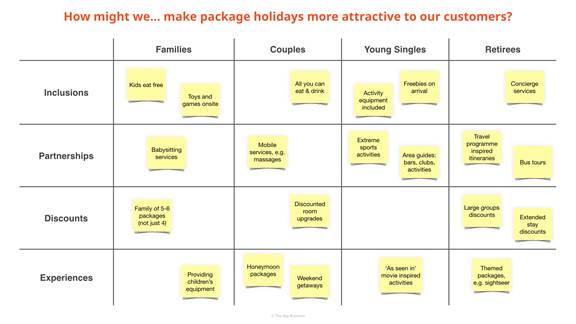In our previous post, we looked at how the creative matrix helps to focus the innovation process, providing clear parameters to guide lateral thinking. In this post, we’ll teach you how to run a creative matrix workshop in ten simple steps.

10 steps to running a creative matrix workshop in your business

#1 Dedicated collaboration space
Start with wall space or a large whiteboard, or if you’re working remotely check out some great collab tools such as Miro or Mural. Ensure everyone is set-up, either with enough stationary or understands how the tool works,. Working analog is often a preference for workshops, as it naturally encourages people not to be precious about their ideas. Which ever way you chose, participants owning their own contribution allows for fluidity, with people able to move their ideas around the board if necessary.
#2 Start with a problem, or a ‘how might we...’
You need a problem to solve. Context is vital in ensuring ideation yields real value. If the table axes (see image above) are the guardrails keeping you on track, then the problem statement is the light guiding you in the right direction. Let’s take the example of a travel company whose sales of package holidays are declining. The problem statement might be “how might we... make package holidays more attractive to our customers?”
#3 Draw up matrix
Create a grid by putting your customer segments, user types, actors or personas as column headings. In the row headings to the left, list categories or components. Taking the example of package holidays, you would list your customer segments along the top (e.g. families, couples, young single travellers, retirees) and categories down the left side (e.g. inclusions, partnerships, discounts, experiences). The cells of this grid represent the intersection of each customer segment and category. During ideation, this inspires participants to consider a variety of circumstances they might not have otherwise.
A helpful tip: Many people add a ‘wildcard’ column, so as not to limit thinking to existing customer segments. It also creates a space for ideas that don’t fit in the boxes exactly.
#4 Have a designated facilitator and get the right people in the room
Like with any good workshop, expert facilitation is required to keep participants on track, to challenge and stretch thinking, to ensure the right balance of voices and opinions, and to keep time. Similarly, the quality of the ideas is only as diverse as the people in the room. Though it will be largely dependent on the outcomes you’re trying to achieve, as a general rule it is important to include key decision makers, subject matter experts and people with a diversity experience and skill set.
Typically, an hour long session will run as follows:
• 10 minutes to explain how the session will run,
• 15 minutes of ideation (5 of those in silence),
• 15 for a walk through of key ideas from individual group members,
• 15 minutes of affinity mapping, and
• 5 for deciding which ideas to progress.
Tip: If you’re running a session with a large group, consider breaking the room up into smaller subsets, if you’re working remotely, zoom has a great ‘breakout’ setting you can use..
#5 Ideate
Give the room 15 minutes to think of as many ideas as possible. They should write down one idea per “Post-it”, placing it in the relevant cell, e.g. an idea about “extreme sports tours” might be a way of engaging young single travellers, so would belong in the intersection of that customer segment and ‘partnerships’. It’s helpful to institute five minutes of silent ideation at the start, so people can think free of distraction. The next ten minutes are more flexible and teaming up is permitted. It’s also important to encourage participants to populate cells that are lighter on ideas, as this will stretch the boundaries of their existing thinking.
Tip: Ask the team if they’d like some music! This can help prevent a lull and keep energy flowing.
Remote Tip: Check if your remote collaboration tool has a timer, most do and will sound a small alarm when time’s up.
#6 Discuss the ideas on the wall
Once the brainstorming is complete and ideas are on show each participant should talk through a few of their own ideas. This encourages participants to empathise with their teammates’ thought processes. It’s important to discuss, challenge and refine ideas, as this is how concepts are stress-tested and developed.
Tip: In workshop situations, some people will always be more vocal than others, so encourage those who are quieter to explain their ideas by asking follow up questions.
#7 Affinity map the ideas created
Throughout the discussion, it’s likely that patterns or themes will have emerged. Ask participants to move the “Post-it's” around the board into groups based on similarity. As a facilitator, make sure the groupings aren’t too large as the ideas will lose their definition and become vague. Summarise each of these groupings in a pithy statement (it’s helpful to use a different coloured Post-it) and place it with the relevant cluster. For example, one group might be “partnerships with activity companies” and another “themed holiday packages based on interests”. Keep in mind that some ideas will be unique and won’t fit in a group - and that is completely fine.
#8 Decide which ideas to progress
Once the room is happy with the idea groupings, it’s time to collectively decide which ideas to progress. That doesn’t mean taking an idea and building it out immediately. Depending on the nature of your parameters, problem statement and outputs, next steps could be to elaborate ideas further using tools like the lean business canvas or storyboarding. If the idea is already somewhat fleshed out, it could be time to visualise concepts and validate them with users.
Tip: If it’s unlikely that the room will come to a consensus on which ideas to progress, consider dot voting as a way of identifying front-runners.
Remote Tip: Tools like Miro and Mural often have templates for canvases and boards already built in!
#9 Customise your matrix
The table axes can and should be designed to suit your particular aims. The point is to innovate, so don’t be afraid to innovate on the process itself. Effective workshops are ones that have been carefully designed and adapted to suit your own unique context. For example, if your team can only think of surprise and delight ideas for features at the expense of expected functionality, you might decide to put high level feature ideas on the top axis instead of customer segments and surprise/delight factor on the left axis. This will nudge participants to think of basic as well as exciting functionality per existing high level feature idea. What is most important is that your axes are determined by the problems you’re trying to solve.
#10 Have fun!
Seriously, have fun! Workshops run best when participants are engaged and enjoying themselves. There’s nothing worse than feeling pressured to come up with ‘good ideas’ in a clinical, formal environment. An effective facilitator will create a safe space, where participants feel comfortable to express their ideas freely. To help get that feeling going, especially if you’re working with a group who has not worked closely together before, run some ice breaker activities at the start of the session - this will help set up up for a successful, fun, workshop!
Good luck!